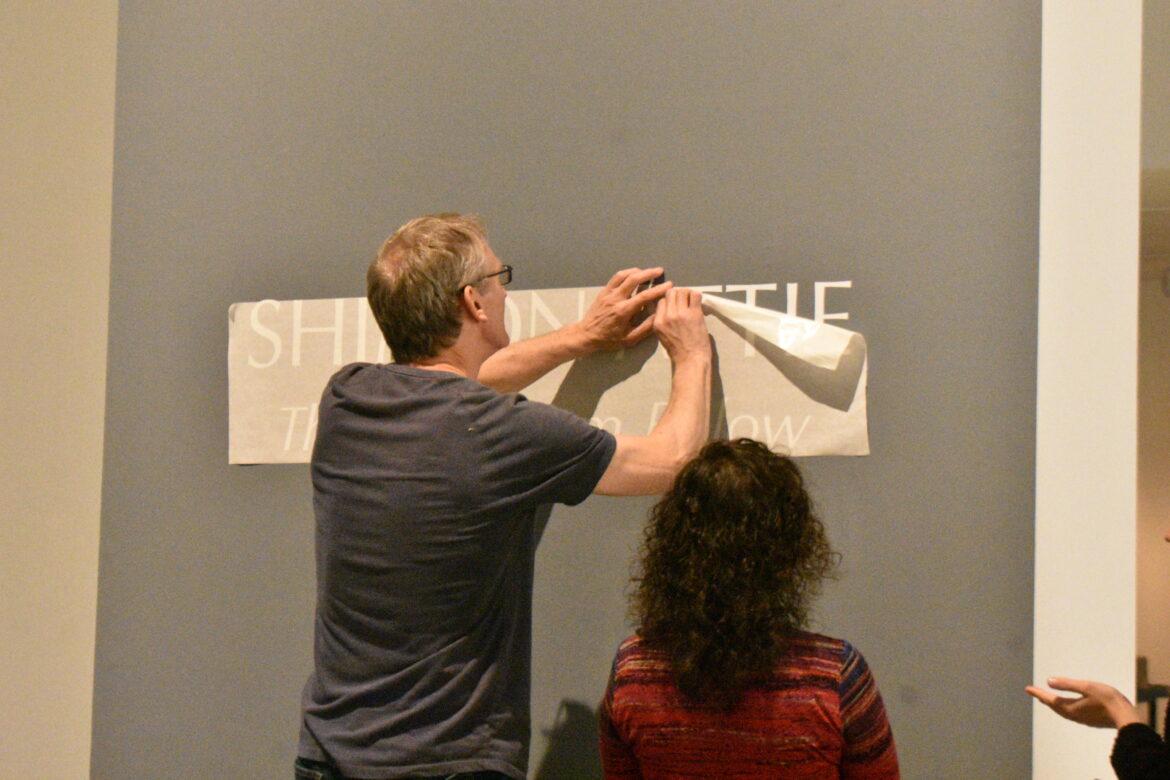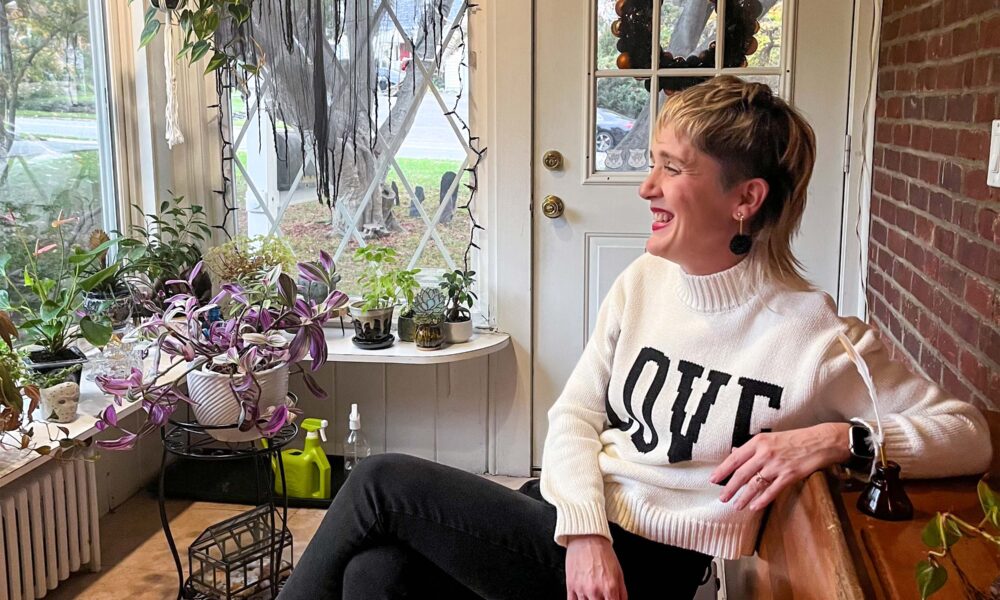Photo by Sophia Trifoli

Nestled into the eastern corner of Stony Brook University West Campus is the Staller Center for the Arts. Inside this building is an even smaller nook of the college’s “STEM heavy” campus — the Paul W. Zuccaire Gallery, a dynamic gallery space, which features contemporary, professional and student art. The visual narratives being told in this space are the result of a deep, calculated production, planned years before being exhibited.
This summer, curator and director of the Zuccaire Gallery, Karen Levitov, gave me the opportunity to intern there, helping install the latest exhibition — “Shimon Attie: The View from Below.” I documented the elusive experience of installing an art exhibition, and here’s what I learned.
Shimon Attie
“Shimon Attie: The View from Below” is a solo art exhibition featuring the work of world-renowned visual artist Shimon Attie. Attie’s work, consisting mostly of video and photo installation pieces, has been exhibited in galleries and museums all over the world, including the National Gallery of Art, The Museum of Modern Art and the Centre Georges Pompidou. In 2020, Attie was invited to teach at Stony Brook University as a visiting art professor. Levitov explained to me that his connection to the school and the professors working in the art department ultimately kindled the curation of his solo exhibition in Zuccaire Gallery.
On his website, Attie describes his work as “a kind of peeling back of the wallpaper of today to reveal the histories buried underneath.” The relationship between themes of memory, identity and location are all explored in Attie’s site-specific installations. Attie himself is of Syrian and Israeli descent, and a member of the LGBTQ+ community. I found myself thinking about two questions: How do I define the word home? What histories of my community are being overlooked? Not only does the show highlight the stories of migrants who fled their countries for a better life, but it also provokes meaningful questions about the viewer’s own relationship with their communities.

Lighting — or the Lack Thereof
One of the first things that catches the eye in the presentation is the gallery space’s dramatically low lighting. In this video-dense project, the low lighting adds clarity to the videos that are being directly projected onto the walls, setting the tone for the viewer’s walk through the gallery.
Simply turning the gallery’s lights off was not going to create the effect of darkness that Attie was hoping for. In order to make the space as dark as possible, retractable curtains were attached to each window to block light coming into the room and to enhance the projected videos. To further the allure, the wall facing the gallery’s entrance depicts the exhibition’s title. During the installation process, this wall became an unexpectedly important aspect of the show, as it blocked excess light from an entrance viewpoint and mystified the content.
Dramatically low lighting was also used to complement the theme of waterways and their symbolism in Attie’s work. Water as a medium can represent movement and is one of the most used forms of transportation by asylum seekers across the world. Attie also closely explores waterways and their significance as a historical form of migration, specifically to immigrants entering the United States.
These steps taken to enhance the darkness coupled with lights concentrated on the hung photographs created the serene and calming atmosphere that the exhibit strives for. Next time you find yourself in an art exhibition, take a moment to think about these often overlooked characteristics of a gallery space that subtly influence your experience.
Projectors
Because the show revolved heavily around video pieces and projects of a large variety, figuring out the placement of projectors was the first and one of the most important steps for Attie. The floorplan of this show is minimalistic in design, as most of the show’s central focuses are on the walls. It was important to find ways to seamlessly incorporate the projectors into the show without them taking away from the show’s ambiance.

The most prominent projector, which posed one of the greatest challenges for the installation crew in terms of its placement, was the one used for the titular piece, “Shimon Attie: The View from Below” — a single channel video that features the water reflections of twelve migrants who had recently been granted asylum in the United States. This video took up the entirety of the gallery’s largest wall and is one of the first pieces that you may see when entering the gallery, so perfecting this projection was extremely important.
When this projection was finished, its meaning and specified importance to Attie in the show made so much sense. This video became bold and eye-catching in all of the right ways.
Making a Movie Theater
From the very beginning of the installation process, this piece distinctly intrigued me. When Attie came to the gallery during its construction, I asked him about the work’s meaning. He explained that the content of the video expands past just gambling for life, but is symbolic in its recreation of the adrenaline rush felt during moments of fear and danger. In hindsight, the immersiveness that the cinematic enhancements add to this piece were pivotal in allowing this piece to be presented in its full potential.

“The Crossing” is an 8-minute long film that explores the feeling of exile and flight held by Syrian refugees who fled their country for a better life. Created with Syrian actors who had recently escaped their homeland, the film shows the participants dressed in formal attire, playing a game of roulette as they symbolically gamble for their lives.
To allow this video to have the intended effect on its audience, its presentation was of paramount importance. Ultimately, it was decided to paint the wall with a special projector paint and to add curtains on both ends of the video to highlight it.
Closed Captioning and Labeling
Accessibility is important in an art exhibition that relies heavily on video pieces.
In this installation, there are two informational videos that help the viewer understand Attie’s site-specific works. These short, documentary-type clips add meaningful and necessary context to the works that were not necessarily created for a gallery setting. Closed captions help the viewer understand the videos and expand accessibility, while labels allow for the pieces to be properly recognized, perceived clearly and accredited.
One of my tasks for this internship was to create all of the closed captions for the exhibition. It was a laborious process, listening to each video and manually transcribing the words of each subject, very consciously emphasizing their thoughts and feelings with spacing and grammar. However, it allowed me to gain a great appreciation for the incredible stories that migrants have been recorded telling.
Photographs
Being extremely careful with the photographs in this exhibit through every step of the process was crucial. Not only can a mistake ruin an installation, but it can also be extremely costly, which is why it is important to closely regulate the artwork’s environment and avoid carelessness.
One of the key steps taken to protect the artwork is controlling the gallery’s climate. After receiving pieces of the art, waiting a day to take the art out of its protective packaging, allowing it to acclimate to the gallery’s temperature, humidity level and overall environment is important. The ideal climate to hold artwork in is one that is dry and has limited exposure to sunlight.

In the process of hanging up the photographs, there were some important anecdotes that I needed to keep in mind — don’t take it “piece by piece,” label everything possible, keep the picture level, understand the gallery space you’re working with.
I also had to simply stand at times. I had to look around and discuss the exhibition with Levitov, Attie and many other amazing people I got to meet. Before finalizing the placement of the artwork, Attie and Levitov insisted at points that we all stand and look at the art, making sure it fit the aesthetics of the show. We would all stand in a line facing the walls lined with photographs, and contemplate the work we were looking at.
More than ever, I learned the importance of slowing down. With the intense pace of production, knowing the appropriate times to slow down and reflect on the process proved to be essential. I learned about some of the most important themes of the show during these gentle moments.
One of my favorite parts of the installation process was being able to visibly discern the amount of progress made by just roaming around the exhibition — a process that felt constantly rewarding.
It was also extremely fruitful in the way it yielded an environment for collaborating and learning.
During this internship, I spent most of my time talking with the gallery’s art installer and temporary assistant director Sibel Yalin, who taught me what it takes to be an installer for distinguished museums and galleries. I also shared lots of my ambitions and dreams with Levitov, and, by the end, I knew I had gained a meaningful connection. These are only to name a few people who had immense influence on me in these two short months.
As time passed during this experience, some of the answers to the questions I posed early — How do I define the word home? What histories of my community are being overlooked? — became easier to answer: I think that home is rather a visceral feeling that the people I hold closest to me bring out. Yes, my family house in Bay Shore, Long Island, is a location that makes me feel homey, but the notion of home is something I am constantly searching for and experiencing in new people and places, and I always want to be cognisant of how the term home means something different to everyone.
The installation process is the product of years of research, curation and preparation. It is a visual byproduct of the labor and time spent by the curator to understand the art and artists you’re working with. The work put in during these steps is what helps the curator bridge the gap between the audience of the exhibition and the art, and helps them to create an exhibition that leaves a long lasting impression.
“Shimon Attie: The View from Below” allows Attie to amplify the voices of those unheard and share the stories of a search for home.




Comments are closed.